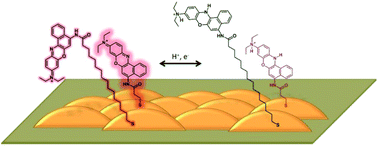Unforeseen distance-dependent SERS spectroelectrochemistry from surface-tethered Nile Blue: the role of molecular orientation†
Abstract
Covalent immobilization of redox-active dyes is an important strategy to evaluate structure–activity relationships in nanoscale electrochemistry by using optical readouts such as surface-enhanced Raman scattering (SERS). Here we investigate the role of the tether length in the SERS spectroelectrochemistry of surface-attached Nile Blue. Differential pulse voltammetry and a potential-dependent SERS derivative analysis reveal that the Nile Blue molecules adopt a different orientation with respect to the electrode surface as the number of carbons in a carboxylic acid-terminated alkanethiol monolayer is varied, which leads to unique SERS spectroelectrochemical behaviors. We use the relative molecular orientations and spectral characteristics to propose a model in which tethers shorter than the length of the molecule limit molecular motion under electrochemical perturbation, but tethers longer than the length of the molecule allow dye intercalation into the hydrophobic self-assembled monolayer, producing an unexpected decrease in the SERS intensity when the molecule is in the oxidized form.

- This article is part of the themed collection: Surface-enhanced Raman scattering

 Please wait while we load your content...
Please wait while we load your content...